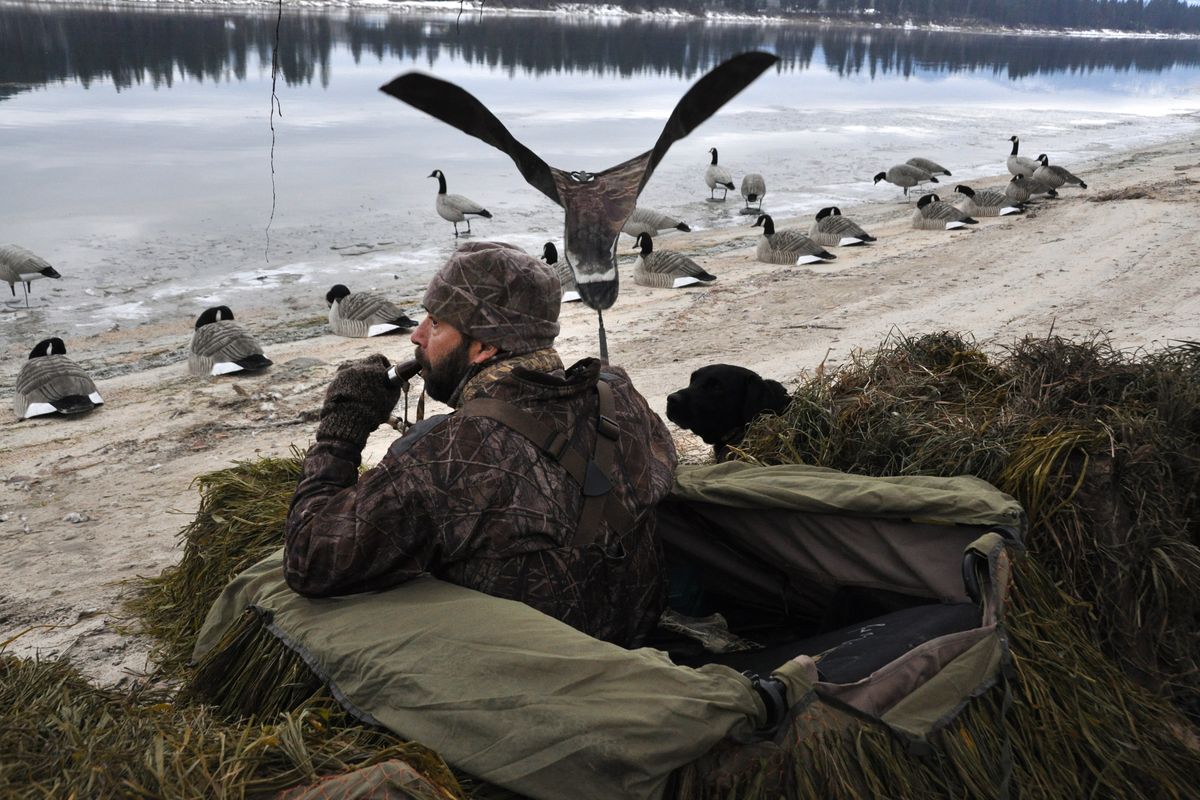Ardent hunter has blind ambition to bag ducks, geese

On a recent weekday, waterfowl hunter Kent Contreras was bubbling with optimism for his coming weekend hunt along the Pend Oreille River.
At least a couple of thousand ducks and geese had been packing into a riverside slough to which he had exclusive access.
But all of his preparations couldn’t overcome clear skies and plunging temperatures that settled into the region. The night before his hunt, ducks were still packed into a portion of the slough, bobbing and churning with their feet to keep a large area ice-free.
But when the diehard waterfowler showed up in the dark last Saturday morning, the cold snap had finally forced the ducks and geese to pack their bags and relocate to open water on the main river. Four nights of temperatures in the teens had sealed the slough with a cap of ice.
This misfortune might have sent hunters with fixed blinds or pits back home for a TV football weekend. The ground was frozen, and digging a pit was out of the question. The grass in this area had been grazed and building a makeshift blind would be difficult.
Nevertheless, Contreras and his Labrador retriever, Tank, were as free as vagabonds to seek another hunting site.
Pulling a trailer full of decoys, he motored to the river on his ATV and sought a decent spot where there was a bit of cover and not too much ice along the water’s edge. Wearing insulated waders, he set out several dozen goose and duck decoys on shore and in the water.
Then, with less than 30 minutes before shooting time, he unpacked his ace in the hole – an Avery Outdoors layout blind that required all of 3 minutes to set up and provide the concealment needed to ambush unsuspecting waterfowl.
In an instant he popped up another blind for Tank and switched off his headlamp for good.
Minutes before official shooting time, the first duck had locked its wings to splash down and swim around his decoys.
“The only real problem with a layout blind is that it’s so comfortable some guys are tempted to doze off,” he whispered as he waited.
Contreras had reclined into the little cocoon as though he were settling in to watch TV after a hard day’s work. He’d pulled two flaps closed over his chest and legs, leaving only his face exposed through the brown, grassy camouflage cover that a can be changed to blend in with different habitats.
He was snug in the cocoon, which warded off the icy chill of the morning until the first flight of Canada geese zeroed in on his decoy spread.
Tank’s eyes and head were tracking the birds like radar. When the geese were in range, Contreras resembled a Halloween corpse gag popping upright from a coffin. The spring-loaded flaps on the blind snapped open, enabling the hunter full freedom to sit up, raise his shotgun and bag the first goose of the day.
Tank also seemed spring- loaded as he launched out of his dog-house blind to make the retrieve.
They were an inspiring pair to behold. After fetching a bird, Tank would shake off the excess water and ice from his thick coat and neoprene vest before crawling quickly into his separate blind.
Then, defying a dog’s normal disposition to go bonkers, Tank poked out his head and lay still in wait for the next flight.
Contreras was equally disciplined. Waterfowling is his game.
He doesn’t hunt big game, nor does he ski or dabble in other recreational diversions from his passion for fooling ducks and geese.
His gear was neat and organized from garage to rig to field. Decoys could be easily deployed in the dark from sectioned bags. No fumbling for shotgun shells. His efficiency in the predawn darkness rivaled the preparedness of Special Forces training.
Everything was thought out, tested and at hand, down to the camouflaged thermos of coffee by his side as the temperature refused to rise for the occasion.
But the big Pend Oreille River was a formidable competitor.
While Contreras got his chances at ducks and geese early on, big flocks of waterfowl began settling down in open bays up and down stream.
For a while, the hunter was able to wave a goose flag to create movement that helped catch the eyes of distant flights coming in from the fields and focus their attention on his decoys. Flagging is one of the easiest, least expensive, yet effective ways to attract geese’s attention at long range and coax them to the spread.
Most of his decoys are designed to balance on pegs so they rock and move with the slightest breeze.
He waved a goose silhouette (some hunters use a black flag) broadly when the geese were specks on the horizon, then called loudly and teased them briefly as they got to 500 yards as though a sitting goose was stretching its wings.
Then he mostly worked his call, sounding like a gaggle of geese rounding up a party.
It all worked, for a while.
Ultimately, his effectiveness was overridden by the bigger gatherings of live birds up and down the river. Flight after flight seemed to be headed his way, only to redirect a half-mile away before dropping like maple leaves into a downstream gathering that was around 1,000 birds.
“It’s hard to compete with live birds,” he shrugged. “Until somebody cruises the river in a boat and stirs things up, it’s going to be awfully quiet here.”
Which brought up perhaps the only shortcoming in the Contreras preparedness.
Looking down at this camouflaged blind bag after a long lull, he said, “A guy should bring a lot bigger lunch for days like this.”